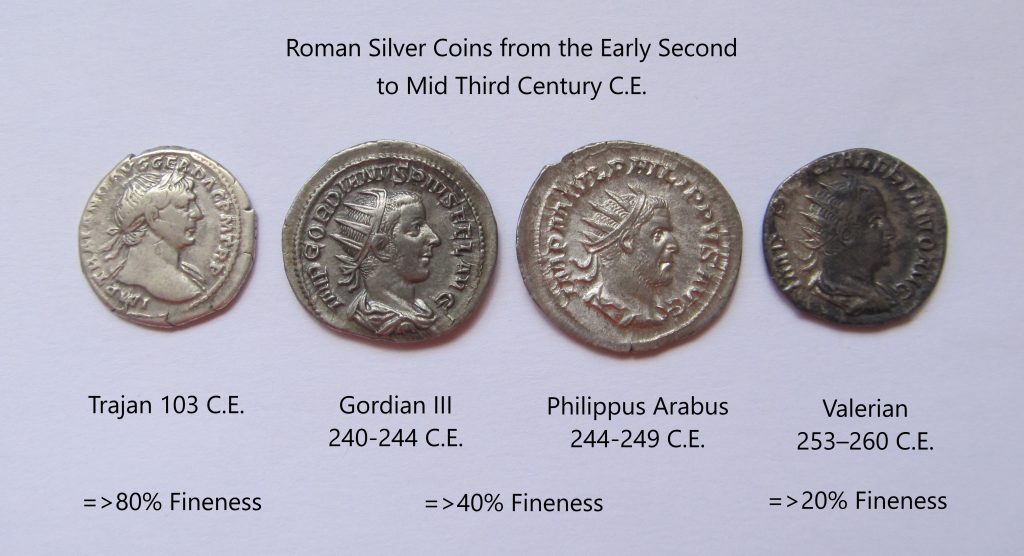Introduction:
This assignment intends to describe the term “debasement” in varying levels of complexity in the form of a parenthetical, sentence, and expanded definition. The term will be described in the context of ancient Roman coinage for a reader with no background in the field.
Parenthetical definition:
Debasement (increasing the base metal content of a coin) of Roman silver coinage during the Crisis of the Third Century resulted in a distrust of the currency (Elliot, 141).
Sentence definition:
| Term | Class | Distinguishing Features |
| Debasement | A monetary policy | Increasing the base metal of a coin to reduce its precious metal content lowering the intrinsic value of the coin.
|
Debasement is a policy where a government increased the proportion of base metal in a coin to reduce its precious metal content lowering the intrinsic value of the coin.
Expanded definition:
Debasement
Origin:
Debasement is a combination of the verb “debase” created from the prefix de (to put down) and the verb base (to lower in condition) with the addition of the suffix ment (“de-prefix”; “base”; “debasement”).
What is debasement and how does it work?
Debasement is a policy where a government increases the proportion of base metal (usually copper) in a coin it mints to reduce its precious metal (gold or silver) content. Creating coins of a lower fineness allows more coins to be produced with the same or lesser amount of precious metal than previously. This makes the coins minted after debasement worth less than those created before the debasement of the coin while affecting the appearance of the debased coins (see figure 1).

Figure 1: Debasement of Roman Silver Coinage. (Cheung, “Roman Silver Coins from the Early Second to Mid Third Century C.E.”)
Historical Examples:
The Roman emperor, Nero, debased the silver coinage during his reign bringing the ratios of silver in Roman coins in line with those of the Greek east. This led to Nero’s silver coinage being worth less than earlier silver coinage (Schwei, 130-131). Septimius Severus also debased his silver coinage, but he did so to the extent that a denarius (a silver coin) was no longer worth sixteen asses (bronze coins), its nominal value (Elliot, 138; Jones, 163).
References:
“base, v.1.” OED Online, Oxford University Press, June 2022, www.oed.com/view/Entry/15855. Accessed 9 June 2022.
“de-, prefix.” OED Online, Oxford University Press, June 2022, www.oed.com/view/Entry/47600. Accessed 9 June 2022.
“debasement, n.” OED Online, Oxford University Press, March 2022, www.oed.com/view/Entry/47833. Accessed 8 June 2022.
Cheung, David. “Roman Silver Coins from the Early Second to Mid Third Century C.E”
Elliot, Colin P. “The Acceptance and Value of Roman Silver Coinage in the Second and Third Centuries AD.” The Numismatic Chronicle (1966-), vol. 174, 2014, pp. 129–52. JSTOR, http://www.jstor.org/stable/44710189. Accessed 9 Jun. 2022.
Jones, G. D. B. “The Roman Mines at Riotinto.” The Journal of Roman Studies, vol. 70, 1980, pp. 146–65. JSTOR, https://doi.org/10.2307/299560. Accessed 9 Jun. 2022.
Schwei, David S. “Exchange Rates, Neronian Silver Standards, and a Long-Term Plan to Unify the Empire’s Mints.” The Numismatic Chronicle (1966-), vol. 177, 2017, pp. 107–34. JSTOR, http://www.jstor.org/stable/26637374. Accessed 9 Jun. 2022.
Leave a Reply